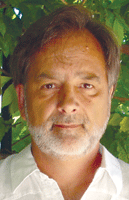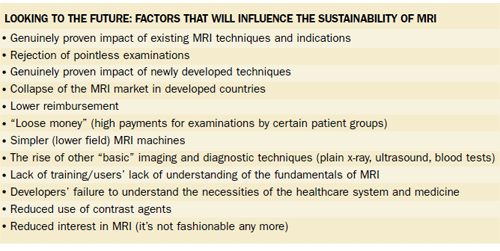Three decades take MRI from cutting edge to sustainability
Thirty years ago, I counted 12 MRI machines worldwide. Once the total had passed 25,000, I gave up counting.
Thirty years ago, I counted 12 MRI machines worldwide. Once the total had passed 25,000, I gave up counting. Yet I wonder how many MRI systems will be in operation in 30 years' time? The highest field strength for human MRI applications 30 years ago was 0.15T. Today it is 7T. And 30 year's from now? We will see (or perhaps not).

The development of MRI has been accompanied by paradigm shifts, changes in basic assumptions regarding conventional wisdom. Back in the 1980s, physicists declared that it would be impossible for MRI to compete with the rapid imaging times of CT because of physical and chemical restrictions imposed by T1 and T2 relaxation times. They also claimed that it would be impossible to image the human body with a field strength higher than 0.3T. As we know today, both scientific statements were wrong.
For most of my scientific and medical life, from the very beginning of MRI, I subscribed to the view that MRI should be promoted. I always believed MRI to be a clean and clear science, but it is not. Clinical MRI is based on subjective perceptions, as are all diagnostic imaging techniques.
Medicine can be found in the middle ground between art and science. Diagnostic imaging is one of the pillars of modern medicine, but in spite of all the numbers and equations, the clinical part is as much an art as it is a science.
Although accomplished radiologists check numbers and curves, they also trust their eyes and rely on their visual perception, their memory, and their cognitive processes. Medical imaging, and thus MRI, is not just about what is in the pictures, and neither is it simply pattern recognition. A good medical image reader has an excellent training plus a certain innate, intuitive ability to spot minute inconsistencies on an image and understand the medicine behind them.
Scientists involved in MRI, mostly chemists and physicists, always looked down on the physicians, the radiologists. I could understand this attitude. They had developed a technology that the average radiologist would never grasp, let alone develop. Thirty years ago, I was the only physician at Paul Lauterbur's laboratory for the duration of my stay; one young radiologist among chemists and computer scientists.
Chemists and physicists in Europe and the U.S. conducted the science part of the MRI business (until companies' marketing and financial people took over) and made decisions on how the technology would develop. This has ultimately, though unintentionally, had a negative impact on the technology. The end-user with sole responsibility for patient outcome is, of course, the radiologist.
MRI is a stable technology; 6% of all imaging studies performed in developed countries involve MRI and 10% involve CT. The most popular systems operate at 1.5T, and in the U.S., these units account for approximately 75% of all clinical MRI installations. Few significant technical changes are expected in the near future. Price pressure has resulted in the cost of MRI equipment remaining static or falling, and the introduction of 1.5T systems with fewer bells and whistles. A brand new, state-of-the-art 1.5T MRI machine can be bought for €600,000 or less.
Profit margins on imaging equipment sales are typically low. Manufacturers aim instead to increase revenues through service and maintenance, though this is more difficult in developing markets. The more basic the equipment, the more feasible it becomes for the hospital's medical physics groups or technical staff to service the machines locally.
The highest field strength available for routine clinical imaging is 3T. Sales of high-field systems have, however, been slow, and U.S. hospitals appear to be retreating from 3T in favor of cheaper 1.5T equipment. Some issues relating to 3T MRI, such as energy deposition and dielectric uniformity, have been improved, but other problems remain. The systems are noisy, expensive to service, and can exacerbate imaging artifacts. In addition, there is no proof that imaging at 3T is diagnostically superior to imaging at 1.5T (or lower field strengths). I have yet to find a single scientific paper of substance proving that the diagnostic outcome of patient examinations at 3T is better than at 1.5T.
Three-T was announced as the solution to clinical MRI, but it is not. Instead, it has added another problem to the healthcare system. The “feel good” factor, where one has done everything technically and financially possible, is higher, but this is still not sufficient. What will happen with the recently introduced 7T machines remains to be seen.
MARKET FORCES
A considerable amount of money has been pumped into diagnostic imaging over the past 25 to 30 years, tax money, insurance money, investors' money. The U.S. Government Accountability Office reported in 2008 that high-tech imaging had grown rapidly from 2000 onwards. The office blamed referring physicians' use of MRI, CT, and PET for a doubling of Medicare's imaging-related costs to $14 billion from 2000 to 2006. The availability of MRI more than tripled between 2000 and 2005, with the number of machines per million people growing from 7.6 to 26.6.
The growth in MRI sales has stagnated over the past few years in countries where the modality has become an established part of medical diagnostics. MRI sales have decreased by 30% to 40%, as have sales of CT systems and nuclear medicine equipment. The oversaturated North American market has been worst hit. Sales of MRI units are still on the increase in some emerging markets, including Eastern Europe, Latin America, and Asia.

New players, such as China and India, are expected to drive demand for diagnostic imaging solutions and, to some extent, the direction of technological development. Both countries offer huge internal sales territories, particularly China. Most parts of China and India are extremely poor and have inadequately developed healthcare systems, making low-cost, high-volume imaging solutions essential. These cheaper machines will rapidly spill over into the Western markets.
Mainstream modality manufacturers increasingly have to decide whether new ideas have any clinical and commercial relevance. R&D work will focus more on clinical relevance, in terms of both applications and patient outcomes, than on new pulse sequences, new coils, and new technical functions.
A huge number of imaging examinations are nonessential and it is futile for patients to have these scans. In the U.S., the number of pointless procedures is, fortunately, falling now. From 2010, MRI reimbursement will be lower, which could further affect the number of MRI examinations performed. The price for an MRI examination has already fallen in some European countries, too.
Japanese health authorities pay several times less for MRI than U.S. insurers do. MRI is, nonetheless, widespread in Japan owing to the availability of low-cost MR equipment specifically geared for that market. Cheaper technology operating at lower field strengths could be introduced in the U.S. if healthcare reforms force vendors to make that decision. If this happens, the European market will doubtless follow suit.
Manufacturers are, first and foremost, interested in money. This is their raison d'être, the purpose that justifies their existence. There is nothing wrong with this goal, though the motivation to make money has shaped radiologists' arsenal. It was not in manufacturers' interest to develop a handful of general-purpose systems. Competition between different company departments has brought us the clinical 3T MRI equipment and 128-slice CT scanners. We now have a plethora of diagnostic imaging equipment for rich nerds.
MRI is an extremely sophisticated technology, and as such, it is perfect for extracting even subtle diagnoses. CT is cruder, but mentally a lot easier to comprehend. Both modalities will be challenged and overtaken by different technologies from unexpected directions: digital radiography, ultrasound, and in vitro laboratory tests.
AGING POPULATION
Healthcare resources are being str-etched by the growing proportion of elderly inhabitants in the population, but no government can afford to support everything. Social security funding is being reduced, owing to reductions in the workforce, and services are facing cutbacks. Governments and/or reimbursement agencies will be unable to fund existing standards of care in the future. Rationing already exists and will increase.
Diagnostic imaging services will continue to undergo major changes as we address the rapidly increasing healthcare demands of these aging societies. The escalating chronic disease burden will have to be managed more efficiently. Efficiency and cost-effectiveness will become the key drivers of change, whereas reimbursement will increasingly be linked to patient outcomes.
The number of CT, MRI, and nuclear medicine procedures performed will plateau or perhaps even decline. Patients will be managed at home, avoiding hospital admissions, using ultrasound and portable digital radiography. Diagnosis and follow-up will increasingly rely on in vitro diagnostics, building on advances in metabonomics.
LOW-TECH FUTURE?
Further technological development is not the be-all and end-all of MRI. Circumstances, politics, manufacturers' decisions, and financial considerations can all change-and will change-MRI, radiology, and medicine.
There are not enough well-trained radiologists and radiographers to operate our increasingly sophisticated MRI systems. Why should we waste time considering the future of MRI if there is no one to run the machines and no one who understands the technology? Without an increase in training, all bright new ideas are useless. A country's health system cannot afford medical disciplines and techniques that are not based on solid human foundations. Teleradiology and computer-assisted diagnosis are merely stopgap solutions. To put it another way, if there are no doctors left who know their craft, then the craft will die. Without the human factor you will have too many mistakes. Technically doable is not necessarily feasible.
At the RSNA 2009 meeting, congress president Dr. Gary J. Becker openly, and quite distinctly, called for an end to a culture of preventable medical error and waste, and demanded an improvement in the quality of medical imaging.
My prediction is that 10 years from now we will have a mass market of simplified MRI systems. I have always wanted a low- or medium-field MRI machine, something that is small and attractive, reasonably priced, easy to service and maintain, and simple to use. In other words, a diagnostic imaging machine that any trained physician could operate safely and reliably.
Study: Monitoring of Prostate MRI Exams Could Lead to 75 Percent Reduction of Gadolinium Contrast
March 17th 2025While DCE MRI was deemed helpful in over 67 percent of cases in which it was used, researchers found that monitored prostate MRI exams, which facilitated a 75 percent reduction of DCE MRI sequences, had comparable sensitivity for prostate cancer as non-monitored exams.